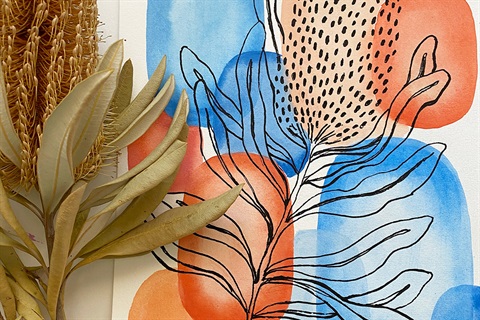Botanical Artwork

You will need:
- Flowers or plants of your choice
- A vase (optional)
- A4 watercolour/mixed media paper (300gsm recommended)
- Watercolour or gouache paints in a range of colours (plus white)
- Black pen/marker or black ink
- Lead pencil and eraser
- Blank paper for sketching design and testing paint colours
- Paintbrushes in a range of sizes from small to medium, with flat and round brush heads, particularly a larger flat brush
- Water jar
- Paper towel/cloth for washing and wiping brushes
1. Choose your colours
Start by creating the coloured background, using the watercolour/gouache paints. Select two colours that you think work well together.
2. Darkest colour
Use your darkest colour for the first layer of the background. Keep the colours you have chosen quite pure, and use lots of water to mix with them to ensure the paint flows smoothly.
Apply the paint in smooth, even brushstrokes, creating two to three rounded-edge shapes of similar sizes, ensuring to leave some space around them (at least 2 cm from the edge of the page).
Use lots of water and allow the centre of the shape to be lighter (by adding more water and less pigment), and then add more pigment to the edges of each shape.
3. Second colour
As the first colour dries, mix your second colour with water then paint another 2-3 shapes of different sizes to balance the composition, still leaving some blank space around them.
4. More shapes!
Gradually add a few more shapes, smaller in size, overlapping with the larger shapes. Still leave some small areas of blank paper exposed.
5. Botanical sketch
When you are happy with your background, leave it to dry and use a pencil and scrap paper to sketch your botanicals. You will be creating a line drawing of them. Plan the size that you will draw them onto your painted background - leaving a margin of at least 5cm at the top and bottom.
6. Copy it over
When you are happy with your sketch, copy it lightly with the lead pencil onto your painted background. The paint should be completely dry before you start drawing.
7. Ink your sketch
Use your black pen/marker or black ink to draw your linear plant drawing over the top of the paint. You may want to make certain lines thicker than others, and perhaps add some patterns to your vase if you have included one in your drawing.
8. Frame it!
When your artwork is finished, put it in a frame for display! You can create variations of this artwork by using different plants, different colour combinations and painting different backgrounds.
Don't forget to share your creations with us through Social Media by using the hashtag #ghcreateathome